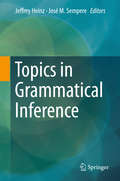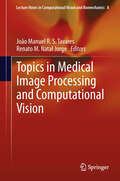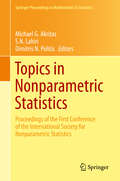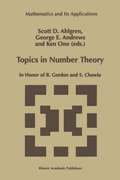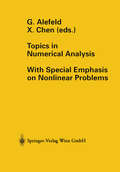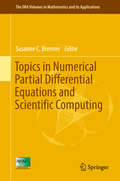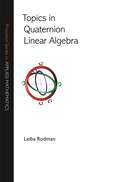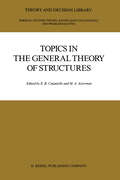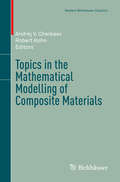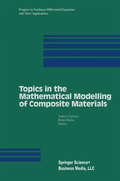- Table View
- List View
Topics in Discrete Mathematics: Dedicated to Jarik Nešetril on the Occasion of his 60th birthday (Algorithms and Combinatorics #26)
by Martin Klazar Jan Kratochvil Martin Loebl Robin Thomas Pavel ValtrThis book comprises a collection of high quality papers in selected topics of Discrete Mathematics, to celebrate the 60th birthday of Professor Jarik Nešetril. Leading experts have contributed survey and research papers in the areas of Algebraic Combinatorics, Combinatorial Number Theory, Game theory, Ramsey Theory, Graphs and Hypergraphs, Homomorphisms, Graph Colorings and Graph Embeddings.
Topics in Electronic Commerce: Second International Symposium, ISEC 2001 Hong Kong, China, April 26-28, 2001 Proceedings (Lecture Notes in Computer Science #2040)
by Weidong Kou Yelena Yesha Chung J. TanThe second International Symposium on Electronic Commerce was held in Hong Kong, April 2001, in conjunction with the fourth International Workshop on the Technological Challenges of Electronic Commerce. This symposium belongs to the- commerce conference series started in 1998 in Toronto, Canada. Since then, every year, there has been an international workshop on the technological challenges of electronic commerce, and every other year, in conjunction with the workshop, an international symposium on electronic commerce is held. The following workshops have been held so far. • The first International Workshop on the Technological Challenges of Electronic Commerce was held in September 1998, in Toronto, Canada. • The second International Workshop on the Technological Challenges of Electronic Commerce was held in May 1999, in Beijing, China. • The third International Workshop on the Technological Challenges of Electronic Commerce was held in June 2000, in Waterloo, Canada • The fourth International Workshop on the Technological Challenges of Electronic Commerce was held in April 2001, in Hong Kong. The first International Symposium on Electronic Commerce was held in Beijing, China, May 1999, in conjunction with the second International Workshop on the Technological Challenges of Electronic Commerce.
Topics in Engineering Mathematics: Modeling and Methods (Mathematics and Its Applications #81)
by A. H. Van Der Burgh J. SimonisTopics in Expert System Design: Methodologies and Tools (Studies in Computer Science and Artificial Intelligence #Volume 5)
by C. Tasso G. GuidaExpert Systems are so far the most promising achievement of artificial intelligence research. Decision making, planning, design, control, supervision and diagnosis are areas where they are showing great potential. However, the establishment of expert system technology and its actual industrial impact are still limited by the lack of a sound, general and reliable design and construction methodology.This book has a dual purpose: to offer concrete guidelines and tools to the designers of expert systems, and to promote basic and applied research on methodologies and tools. It is a coordinated collection of papers from researchers in the USA and Europe, examining important and emerging topics, methodological advances and practical experience obtained in specific applications. Each paper includes a survey introduction, and a comprehensive bibliography is provided.
Topics in Galois Fields (Algorithms and Computation in Mathematics #29)
by Dirk Hachenberger Dieter JungnickelThis monograph provides a self-contained presentation of the foundations of finite fields, including a detailed treatment of their algebraic closures. It also covers important advanced topics which are not yet found in textbooks: the primitive normal basis theorem, the existence of primitive elements in affine hyperplanes, and the Niederreiter method for factoring polynomials over finite fields.We give streamlined and/or clearer proofs for many fundamental results and treat some classical material in an innovative manner. In particular, we emphasize the interplay between arithmetical and structural results, and we introduce Berlekamp algebras in a novel way which provides a deeper understanding of Berlekamp's celebrated factorization algorithm.The book provides a thorough grounding in finite field theory for graduate students and researchers in mathematics. In view of its emphasis on applicable and computational aspects, it is also useful for readers working in information and communication engineering, for instance, in signal processing, coding theory, cryptography or computer science.
Topics in Geometry, Coding Theory and Cryptography (Algebra and Applications #6)
by Arnaldo Garcia Henning StichtenothThe theory of algebraic function fields over finite fields has its origins in number theory. However, after Goppa`s discovery of algebraic geometry codes around 1980, many applications of function fields were found in different areas of mathematics and information theory. This book presents survey articles on some of these new developments. The topics focus on material which has not yet been presented in other books or survey articles.
Topics in Grammatical Inference
by Jeffrey Heinz José M. SempereThis book explains advanced theoretical and application-related issues in grammatical inference, a research area inside the inductive inference paradigm for machine learning. The first three chapters of the book deal with issues regarding theoretical learning frameworks; the next four chapters focus on the main classes of formal languages according to Chomsky's hierarchy, in particular regular and context-free languages; and the final chapter addresses the processing of biosequences. The topics chosen are of foundational interest with relatively mature and established results, algorithms and conclusions. The book will be of value to researchers and graduate students in areas such as theoretical computer science, machine learning, computational linguistics, bioinformatics, and cognitive psychology who are engaged with the study of learning, especially of the structure underlying the concept to be learned. Some knowledge of mathematics and theoretical computer science, including formal language theory, automata theory, formal grammars, and algorithmics, is a prerequisite for reading this book.
Topics in Industrial Mathematics: Case Studies and Related Mathematical Methods (Applied Optimization #42)
by H Neunzert Abul Hasan SiddiqiIndustrial Mathematics is a relatively recent discipline. It is concerned primarily with transforming technical, organizational and economic problems posed by indus try into mathematical problems; "solving" these problems byapproximative methods of analytical and/or numerical nature; and finally reinterpreting the results in terms of the original problems. In short, industrial mathematics is modelling and scientific computing of industrial problems. Industrial mathematicians are bridge-builders: they build bridges from the field of mathematics to the practical world; to do that they need to know about both sides, the problems from the companies and ideas and methods from mathematics. As mathematicians, they have to be generalists. If you enter the world of indus try, you never know which kind of problems you will encounter, and which kind of mathematical concepts and methods you will need to solve them. Hence, to be a good "industrial mathematician" you need to know a good deal of mathematics as well as ideas already common in engineering and modern mathematics with tremen dous potential for application. Mathematical concepts like wavelets, pseudorandom numbers, inverse problems, multigrid etc., introduced during the last 20 years have recently started entering the world of real applications. Industrial mathematics consists of modelling, discretization, analysis and visu alization. To make a good model, to transform the industrial problem into a math ematical one such that you can trust the prediction of the model is no easy task.
Topics in Knot Theory (Nato Science Series C: #399)
by M. E. BozhüyükTopics in Knot Theory is a state of the art volume which presents surveys of the field by the most famous knot theorists in the world. It also includes the most recent research work by graduate and postgraduate students. The new ideas presented cover racks, imitations, welded braids, wild braids, surgery, computer calculations and plottings, presentations of knot groups and representations of knot and link groups in permutation groups, the complex plane and/or groups of motions. For mathematicians, graduate students and scientists interested in knot theory.
Topics in Matroid Theory (SpringerBriefs in Optimization)
by Leonidas S. PitsoulisTopics in Matroid Theory provides a brief introduction to matroid theory with an emphasis on algorithmic consequences.Matroid theory is at the heart of combinatorial optimization and has attracted various pioneers such as Edmonds, Tutte, Cunningham and Lawler among others. Matroid theory encompasses matrices, graphs and other combinatorial entities under a common, solid algebraic framework, thereby providing the analytical tools to solve related difficult algorithmic problems. The monograph contains a rigorous axiomatic definition of matroids along with other necessary concepts such as duality, minors, connectivity and representability as demonstrated in matrices, graphs and transversals. The author also presents a deep decomposition result in matroid theory that provides a structural characterization of graphic matroids, and show how this can be extended to signed-graphic matroids, as well as the immediate algorithmic consequences.
Topics in Medical Image Processing and Computational Vision (Lecture Notes in Computational Vision and Biomechanics #8)
by João Manuel R. S. Tavares and Renato M. Natal JorgeThe sixteen chapters included in this book were written by invited experts of international recognition and address important issues in Medical Image Processing and Computational Vision, including: Object Recognition, Object Detection, Object Tracking, Pose Estimation, Facial Expression Recognition, Image Retrieval, Data Mining, Automatic Video Understanding and Management, Edges Detection, Image Segmentation, Modelling and Simulation, Medical thermography, Database Systems, Synthetic Aperture Radar and Satellite Imagery.Different applications are addressed and described throughout the book, comprising: Object Recognition and Tracking, Facial Expression Recognition, Image Database, Plant Disease Classification, Video Understanding and Management, Image Processing, Image Segmentation, Bio-structure Modelling and Simulation, Medical Imaging, Image Classification, Medical Diagnosis, Urban Areas Classification, Land Map Generation.The book brings together the current state-of-the-art in the various multi-disciplinary solutions for Medical Image Processing and Computational Vision, including research, techniques, applications and new trends contributing to the development of the related areas.
Topics in Nonlinear Mechanics and Physics: Selected Papers from CSNDD 2018 (Springer Proceedings in Physics #228)
by Mohamed BelhaqThis book presents a selection of contributions from the 4th International Conference on Structural Nonlinear Dynamics and Diagnostics, reflecting diverse aspects of nonlinear and complex dynamics. Fifteen chapters discuss the latest findings and applications in active research areas in nonlinear mechanics and physics. These includes the dynamics of ships with liquid sloshing interaction, dynamics of drops and bubbles, nonlinear drying processes, suppression of time-delayed induced vibrations, dynamics of robotic systems, chaos detection in rolling element, dynamics of a planetary gear system with faults, vibro-impact systems, complex fractional moments for nonlinear systems, oscillations under hysteretic conditions, as well as topics in nonlinear energy harvesting and control.
Topics in Nonparametric Statistics: Proceedings of the First Conference of the International Society for Nonparametric Statistics (Springer Proceedings in Mathematics & Statistics #74)
by Michael G. Akritas S. N. Lahiri Dimitris N. PolitisThis volume is composed of peer-reviewed papers that have developed from the First Conference of the International Society for Non Parametric Statistics (ISNPS). This inaugural conference took place in Chalkidiki, Greece, June 15-19, 2012. It was organized with the co-sponsorship of the IMS, the ISI and other organizations. M.G. Akritas, S.N. Lahiri and D.N. Politis are the first executive committee members of ISNPS and the editors of this volume. ISNPS has a distinguished Advisory Committee that includes Professors R.Beran, P.Bickel, R. Carroll, D. Cook, P. Hall, R. Johnson, B. Lindsay, E. Parzen, P. Robinson, M. Rosenblatt, G. Roussas, T. SubbaRao and G. Wahba. The Charting Committee of ISNPS consists of more than 50 prominent researchers from all over the world.The chapters in this volume bring forth recent advances and trends in several areas of nonparametric statistics. In this way, the volume facilitates the exchange of research ideas, promotes collaboration among researchers from all over the world and contributes to the further development of the field. The conference program included over 250 talks, including special invited talks, plenary talks and contributed talks on all areas of nonparametric statistics. Out of these talks, some of the most pertinent ones have been refereed and developed into chapters that share both research and developments in the field.
Topics in Number Theory: In Honor of B. Gordon and S. Chowla (Mathematics and Its Applications #467)
by Scott D. Ahlgren George E. Andrews Ken OnoFrom July 31 through August 3,1997, the Pennsylvania State University hosted the Topics in Number Theory Conference. The conference was organized by Ken Ono and myself. By writing the preface, I am afforded the opportunity to express my gratitude to Ken for beng the inspiring and driving force behind the whole conference. Without his energy, enthusiasm and skill the entire event would never have occurred. We are extremely grateful to the sponsors of the conference: The National Sci ence Foundation, The Penn State Conference Center and the Penn State Depart ment of Mathematics. The object in this conference was to provide a variety of presentations giving a current picture of recent, significant work in number theory. There were eight plenary lectures: H. Darmon (McGill University), "Non-vanishing of L-functions and their derivatives modulo p. " A. Granville (University of Georgia), "Mean values of multiplicative functions. " C. Pomerance (University of Georgia), "Recent results in primality testing. " C. Skinner (Princeton University), "Deformations of Galois representations. " R. Stanley (Massachusetts Institute of Technology), "Some interesting hyperplane arrangements. " F. Rodriguez Villegas (Princeton University), "Modular Mahler measures. " T. Wooley (University of Michigan), "Diophantine problems in many variables: The role of additive number theory. " D. Zeilberger (Temple University), "Reverse engineering in combinatorics and number theory. " The papers in this volume provide an accurate picture of many of the topics presented at the conference including contributions from four of the plenary lectures.
Topics in Numerical Analysis: With Special Emphasis on Nonlinear Problems (Computing Supplementa #15)
by G. Alefeld Xiaojun ChenThis volume contains eighteen papers submitted in celebration of the sixty-fifth birthday of Professor Tetsuro Yamamoto of Ehime University. Professor Yamamoto was born in Tottori, Japan on January 4, 1937. He obtained his B. S. and M. S. in mathematics from Hiroshima University in 1959 and 1961, respec tively. In 1966, he took a lecturer position in the Department of Mathematics, Faculty of General Education, Hiroshima University and obtained his Ph. D. degree from Hiroshima University two years later. In 1969, he moved to the Department of Applied Mathematics, Faculty of Engineering, Ehime University as an associate professor and he has been a full professor of the Department of Mathematics (now Department of Mathematical Sciences), Faculty of Science, since 1975. At the early stage of his study, he was interested in algebraic eigen value problems and linear iterative methods. He published some papers on these topics in high level international journals. After moving to Ehime University, he started his research on Newton's method and Newton-like methods for nonlinear operator equations. He published many papers on error estimates of the methods. He established the remarkable result that all the known error bounds for Newton's method under the Kantorovich assumptions follow from the Newton-Kantorovich theorem, which put a period to the race of finding sharper error bounds for Newton's method.
Topics in Numerical Partial Differential Equations and Scientific Computing (The IMA Volumes in Mathematics and its Applications #160)
by Susanne C. BrennerNumerical partial differential equations (PDEs) are an important part of numerical simulation, the third component of the modern methodology for science and engineering, besides the traditional theory and experiment. This volume contains papers that originated with the collaborative research of the teams that participated in the IMA Workshop for Women in Applied Mathematics: Numerical Partial Differential Equations and Scientific Computing in August 2014.
Topics in Parallel and Distributed Computing: Introducing Concurrency in Undergraduate Courses
by Sushil K. Prasad Anshul Gupta Arnold L. Rosenberg Alan Sussman Charles C. WeemsTopics in Parallel and Distributed Computing provides resources and guidance for those learning PDC as well as those teaching students new to the discipline. The pervasiveness of computing devices containing multicore CPUs and GPUs, including home and office PCs, laptops, and mobile devices, is making even common users dependent on parallel processing. Certainly, it is no longer sufficient for even basic programmers to acquire only the traditional sequential programming skills. The preceding trends point to the need for imparting a broad-based skill set in PDC technology. However, the rapid changes in computing hardware platforms and devices, languages, supporting programming environments, and research advances, poses a challenge both for newcomers and seasoned computer scientists. This edited collection has been developed over the past several years in conjunction with the IEEE technical committee on parallel processing (TCPP), which held several workshops and discussions on learning parallel computing and integrating parallel concepts into courses throughout computer science curricula. - Contributed and developed by the leading minds in parallel computing research and instruction - Provides resources and guidance for those learning PDC as well as those teaching students new to the discipline - Succinctly addresses a range of parallel and distributed computing topics - Pedagogically designed to ensure understanding by experienced engineers and newcomers - Developed over the past several years in conjunction with the IEEE technical committee on parallel processing (TCPP), which held several workshops and discussions on learning parallel computing and integrating parallel concepts
Topics in Parallel and Distributed Computing: Enhancing the Undergraduate Curriculum: Performance, Concurrency, and Programming on Modern Platforms
by Sushil K. Prasad Anshul Gupta Arnold Rosenberg Alan Sussman Charles WeemsThis book introduces beginning undergraduate students of computing and computational disciplines to modern parallel and distributed programming languages and environments, including map-reduce, general-purpose graphics processing units (GPUs), and graphical user interfaces (GUI) for mobile applications. The book also guides instructors via selected essays on what and how to introduce parallel and distributed computing topics into the undergraduate curricula, including quality criteria for parallel algorithms and programs, scalability, parallel performance, fault tolerance, and energy efficiency analysis. The chapters designed for students serve as supplemental textual material for early computing core courses, which students can use for learning and exercises. The illustrations, examples, and sequences of smaller steps to build larger concepts are also tools that could be inserted into existing instructor material. The chapters intended for instructors are written at a teaching level and serve as a rigorous reference to include learning goals, advice on presentation and use of the material, within early and advanced undergraduate courses. Since Parallel and Distributed Computing (PDC) now permeates most computing activities, imparting a broad-based skill set in PDC technology at various levels in the undergraduate educational fabric woven by Computer Science (CS) and Computer Engineering (CE) programs as well as related computational disciplines has become essential. This book and others in this series aim to address the need for lack of suitable textbook support for integrating PDC-related topics into undergraduate courses, especially in the early curriculum. The chapters are aligned with the curricular guidelines promulgated by the NSF/IEEE-TCPP Curriculum Initiative on Parallel and Distributed Computing for CS and CE students and with the CS2013 ACM/IEEE Computer Science Curricula.
Topics in Performance Evaluation, Measurement and Characterization: Third TPC Technology Conference, TPCTC 2011, Seattle, WA, USA, August 29- September 3, 2011. Revised Selected Papers (Lecture Notes in Computer Science #7144)
by Raghunath Nambiar Meikel PoessThis book constitutes the proceedings of the Third Technology Conference on Performance Evaluation and Benchmarking, TPCTC 2011, held in conjunction with the 37th International Conference on Very Large Data Bases, VLDB 2011, in Seattle, August/September 2011. The 12 full papers and 2 keynote papers were carefully selected and reviewed from numerous submissions. The papers present novel ideas and methodologies in performance evaluation, measurement, and characterization.
Topics in Quaternion Linear Algebra
by Leiba RodmanQuaternions are a number system that has become increasingly useful for representing the rotations of objects in three-dimensional space and has important applications in theoretical and applied mathematics, physics, computer science, and engineering. This is the first book to provide a systematic, accessible, and self-contained exposition of quaternion linear algebra. It features previously unpublished research results with complete proofs and many open problems at various levels, as well as more than 200 exercises to facilitate use by students and instructors. Applications presented in the book include numerical ranges, invariant semidefinite subspaces, differential equations with symmetries, and matrix equations.Designed for researchers and students across a variety of disciplines, the book can be read by anyone with a background in linear algebra, rudimentary complex analysis, and some multivariable calculus. Instructors will find it useful as a complementary text for undergraduate linear algebra courses or as a basis for a graduate course in linear algebra. The open problems can serve as research projects for undergraduates, topics for graduate students, or problems to be tackled by professional research mathematicians. The book is also an invaluable reference tool for researchers in fields where techniques based on quaternion analysis are used.
Topics in Quaternion Linear Algebra
by Leiba RodmanQuaternions are a number system that has become increasingly useful for representing the rotations of objects in three-dimensional space and has important applications in theoretical and applied mathematics, physics, computer science, and engineering. This is the first book to provide a systematic, accessible, and self-contained exposition of quaternion linear algebra. It features previously unpublished research results with complete proofs and many open problems at various levels, as well as more than 200 exercises to facilitate use by students and instructors. Applications presented in the book include numerical ranges, invariant semidefinite subspaces, differential equations with symmetries, and matrix equations.Designed for researchers and students across a variety of disciplines, the book can be read by anyone with a background in linear algebra, rudimentary complex analysis, and some multivariable calculus. Instructors will find it useful as a complementary text for undergraduate linear algebra courses or as a basis for a graduate course in linear algebra. The open problems can serve as research projects for undergraduates, topics for graduate students, or problems to be tackled by professional research mathematicians. The book is also an invaluable reference tool for researchers in fields where techniques based on quaternion analysis are used.
Topics in Rough Set Theory: Current Applications to Granular Computing (Intelligent Systems Reference Library #168)
by Seiki Akama Yasuo Kudo Tetsuya MuraiThis book discusses current topics in rough set theory. Since Pawlak’s rough set theory was first proposed to offer a basis for imprecise and uncertain data and reasoning from data, many workers have investigated its foundations and applications. Examining various topical issues, including object-oriented rough set models, recommendation systems, decision tables, and granular computing, the book is a valuable resource for students and researchers in the field.
Topics in the General Theory of Structures (Theory and Decision Library D: #1)
by E. R. Caianiello M. A. AizermanThis volume is about "Structure". The search for "structure", always the pursuit of sciences within their specific areas and perspectives, is witnessing these days a dra matic revolution. The coexistence and interaction of so many structures (atoms, hu mans, cosmos and all that there is in between) would be unconceivable according to many experts, if there were not, behind it all, some gen eral organizational principle. s that (at least in some asymptotic way) make possible so many equilibria among species and natural objects, fan tastically tuned to an extremely high degree of precision. The evidence accumulates to an increasingly impressive degree; a concrete example comes from physics, whose constant aim always was and is that of searching for "ultimate laws", out of which everything should follow, from quarks to the cosmos. Our notions and philosophy have un dergone major revolutions, whenever the "unthinkable" has been changed by its wonderful endeavours into "fact". Well, it is just from physics that evidence comes: even if the "ultimate" could be reached, it would not in any way be a terminal point. When "complexity" comes into the game, entirely new notions have to be invented; they all have to do with "structure", though this time in a much wider sense than would have been understood a decade or so ago.
Topics in the Mathematical Modelling of Composite Materials (Modern Birkhäuser Classics)
by Andrej V. Cherkaev Robert KohnOver the past several decades, we have witnessed a renaissance of theoretical work on the macroscopic behavior of microscopically heterogeneous materials. This activity brings together a number of related themes, including: (1) the use of weak convergence as a rigorous yet general language for the discussion of macroscopic behavior; (2) interest in new types of questions, particularly the "G-closure problem," motivated in large part by applications of optimal control theory to structural optimization; (3) the introduction of new methods for bounding effective moduli, including one based on "compensated compactness"; and (4) the identification of deep links between the analysis of microstructures and the multidimensional calculus of variations. This work has implications for many physical problems involving optimal design, composite materials, and coherent phase transitions. As a result, it has received attention and support from numerous scientific communities, including engineering, materials science, and physics, as well as mathematics. There is by now an extensive literature in this area. But for various reasons certain fundamental papers were never properly published, circulating instead as mimeographed notes or preprints. Other work appeared in poorly distributed conference proceedings volumes. Still other work was published in standard books or journals, but written in Russian or French. The net effect is a sort of "gap" in the literature, which has made the subject unnecessarily difficult for newcomers to penetrate. The present, softcover reprint is designed to make this classic text available to a wider audience. "Summarizes some of the fundamental results achieved and offers new perspectives in the mechanics of composite and micromechanics... Will become a classic in the two fields." —Applied Mechanics Review
Topics in the Mathematical Modelling of Composite Materials (Progress in Nonlinear Differential Equations and Their Applications #31)
by Andrej V. Cherkaev Robert KohnAndrej V. Cherkaev and Robert V. Kohn In the past twenty years we have witnessed a renaissance of theoretical work on the macroscopic behavior of microscopically heterogeneous mate rials. This activity brings together a number of related themes, including: ( 1) the use of weak convergence as a rigorous yet general language for the discussion of macroscopic behavior; (2) interest in new types of questions, particularly the "G-closure problem," motivated in large part by applications of optimal control theory to structural optimization; (3) the introduction of new methods for bounding effective moduli, including one based on "com pensated compactness"; and (4) the identification of deep links between the analysis of microstructures and the multidimensional calculus of variations. This work has implications for many physical problems involving optimal design, composite materials, and coherent phase transitions. As a result it has received attention and support from numerous scientific communities, including engineering, materials science, and physics as well as mathematics. There is by now an extensive literature in this area. But for various reasons certain fundamental papers were never properly published, circu lating instead as mimeographed notes or preprints. Other work appeared in poorly distributed conference proceedings volumes. Still other work was published in standard books or journals, but written in Russian or French. The net effect is a sort of "gap" in the literature, which has made the subject unnecessarily difficult for newcomers to penetrate.






